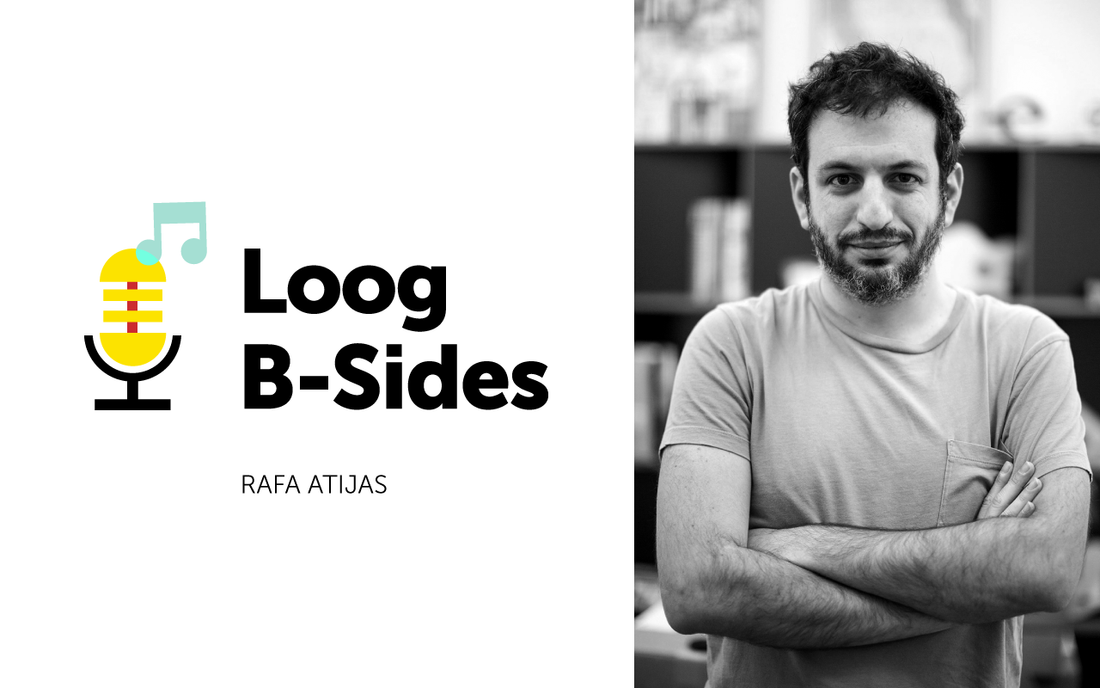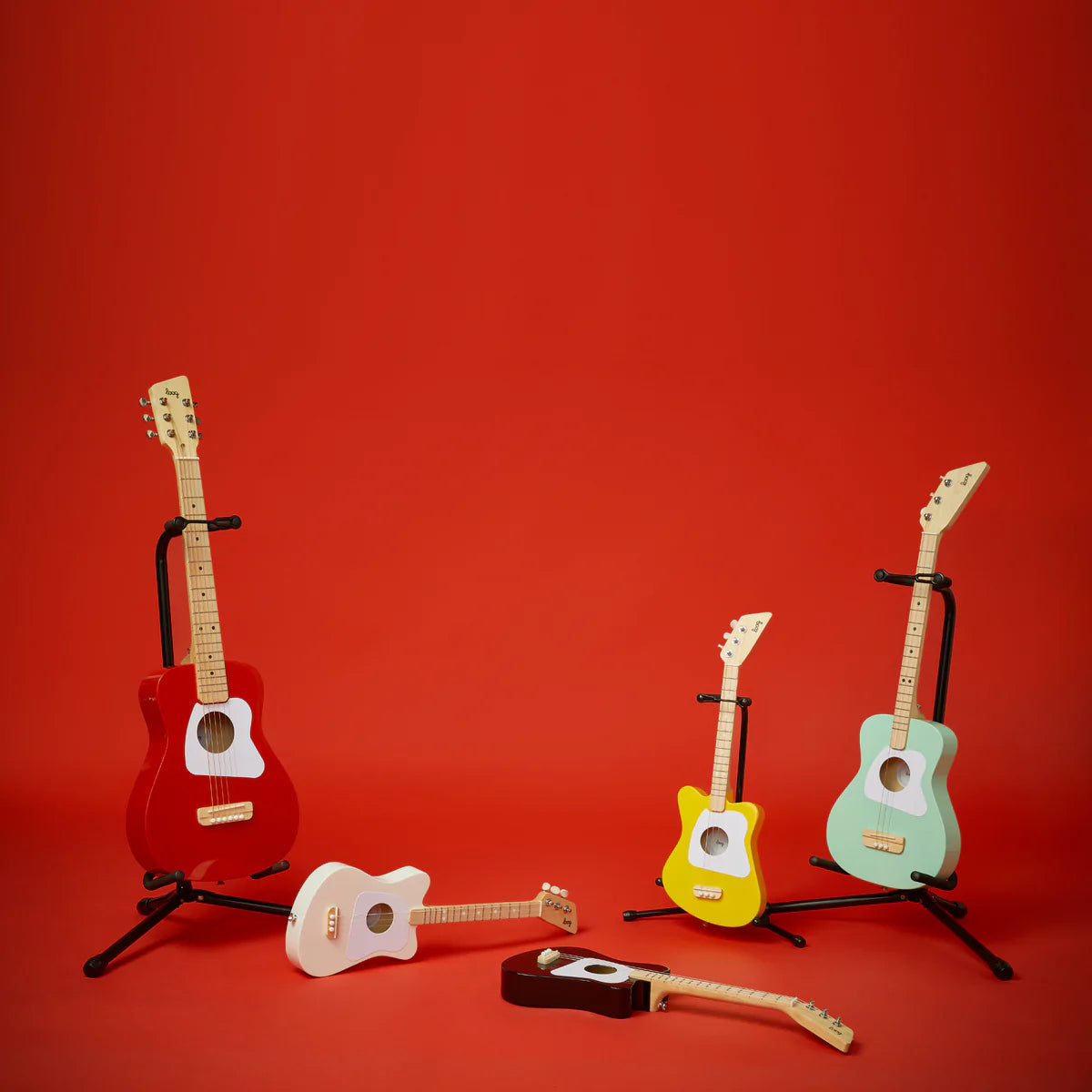
Loog B-Sides: Loog Guitars Turns 11 Years Old
This is the fifth episode of Loog B-Sides, a series of conversations that celebrates and shines a spotlight on some of our fave Loog Community members (and sometimes ourselves, apparently!). You can also listen to excerpts from this feature and others from Loog B-Sides on Spotify.
On Loog B-Sides we usually interview notable people from the Loog Community, featuring conversations around music, kids, education, parenting and more. We turn 11 years old this March so, for this special episode, we decided to look inward and offer a sneak peek into what makes Loog Guitars what it is today.
From who exactly is in our community, to our story, product development standards and, maybe, a little bit of what we’re dreaming about for the future, join us in interviewing our own CEO, Rafa Atijas.
Just remember: what’s said in Loog B-Sides stays in Loog B-Sides, okay? 😉
Don’t feel like reading? You can also listen to an excerpt of this interview on Spotify.

Happy Birthday Loog! How did it all begin?
Loog Guitars actually started out as my thesis when I was studying at NYU. And when the time arrived for me to present what my thesis would be about, I came up with this idea about a children's guitar that wasn't just a small cheap guitar, but was actually designed and thought out to make it fun, easy, and stimulating for little kids to learn how to play. And that's how I came up with the idea of a three-string guitar that would make it easier, less intimidating, and more stimulating for them to wrap their small hands and fingers around the neck and learn to play basic chords and songs. This was actually 11 years ago!
How has Loog evolved since then? When did it become more than just guitars?
It was only a few years ago that we decided to complement all that with educational content. We learned the hard way that three strings actually did make it easier for kids to learn how to play, but that wasn't enough. In order for kids to actually learn, they still needed some guidance. And we didn’t want them to feel like they were just studying from a textbook; that educational content needed to live either in an app or on a website. In any case, it needed to be digital in some way. Today, we also have some printed materials like our Loog flashcards, but it basically all started with the idea of a three-string guitar.

And what about the Loog Community? How did that happen?
I think one of the reasons why there is actually a community around Loog Guitars (be it users, clients, musicians, parents, or kids) is that we started through a Kickstarter campaign. For those who are unfamiliar with Kickstarter, Kickstarter is a funding platform where you show an idea that you have, and if people like it and they're willing to pre-buy it, or pre-order it, then you end up with the money in order to do it, and you actually have to deliver the product. And that's where back in 2011 we went to, with this idea of a three-string guitar, showing my one and only prototype. And there were 500 individuals from all over the world, mainly from the US, but from many, many other countries as well, that thought that this was an idea worth existing.
And through the years, we actually ran a few other campaigns when we had product updates, as well as when we decided to introduce new models. We are also very active on our social media accounts. We don't have a lot of money to do advertising or other sorts of marketing, so we try to be very active on Instagram and on Facebook and all that. And we also try to provide useful content, not just be like “Buy a guitar, buy a guitar!”. We really try to be a source where people can learn how to play, to learn about the benefits of music, to be a place where you can find fun materials for parents to introduce their kids to music that they like. So, sometimes, for example, we might do a cartoon trying to tell people who David Bowie was, and we really think that all those things end up building community. The relationship we have with the people who follow us on social media, who bought a guitar from us, who are subscribed to our email newsletter, or who funded our Kickstarter campaigns, is more of a community relationship and not so much a transactional relationship.
How has this community changed through the years?
When I first started out, I definitely thought “People who are going to buy this are probably musicians, or maybe parents who are really, really into music”. And of course, they don't want to buy one of those cheap supermarket guitars, so they might like what we do. In the end, fortunately for us, it actually grew a lot. This also happened because our price point was broad enough that it's not something that's super, super niche: almost anybody can get a Loog guitar if they want to. And yeah, that's something that we learned. We also got a lot of grandparents buying for their grandkids. So when we thought that maybe it was young, hip parents really into music, well… I guess there are a lot of hip and very cool grandparents too!
So those are things that you end up learning along the way. And no matter how savvy you think you are, or that you can anticipate who your audience is, you end up learning about it when you are out there. So yes, at least in the beginning, we were mainly talking to those kinds of people, young hip parents really into music, maybe even musicians who are looking for something for their kids. And now we have, fortunately for us, a very diverse community where we have young people, old people, people from all over the world, from all walks of life.
One of our fave things about Loog is the design process. Could you tell us a little bit more about that?
Well, first of all, we do that as a team. So it's not just something that happens in my mind, I wish, but it's not. We work with a very talented team, in concrete when it comes to industrial design or broad design. Usually it starts with Joaquin and me, Joaquin is our Head of Design. And I guess there are some guidelines that are actually not written anywhere, but just things that we both know that we want to bring to the table. If we are going to use materials, we want to use good quality materials, and we want to use them honestly. Maybe in some things we might use plastic, but we are going to use plastic if plastic is effectively the best material for that part. And we end up using wood anyway for most of the things we do.

But we try to approach design in a very honest way, I would say. It's not just a question of being minimalist, or super great quality for the sake of being super great quality. Sometimes we try to take things into account, like who is it for, how much it should last, is it good for the planet, if we are using certain materials or not, how is it going to shape, and obviously function. I mean, does it make it fun and easy for kids to play music? Do they want to hold it, is it something that's going to end up lying in a corner, or inside a wardrobe, or is it something that kids are going to want to use? And I guess that's our approach, both when we do physical products, like our musical instruments, but also for our digital content that we distribute through our app.
We care a lot about design. And we know we don't always get it right. Our products change with time, and sometimes we have rough batches too. We are not Apple by any means, we don't yet achieve those levels of perfection, or Lego or whatever. But we definitely care and we definitely try. And we definitely improve with time.
And how has the guitars’ design evolved in these 11 years?
When we first started, all our guitars came unassembled for kids and parents to put together. And the idea behind that, which is an idea I still like a lot, is that by building your own instrument, you are obviously bonding with it on a much deeper level. And if you do it with your parents, you are also bonding with them, and sharing love for music. Now, that's very interesting because that did work with a lot of people but, unfortunately for us, for many, many, many others, it was also a bit frustrating, and even intimidating. And for many of them, building the guitar ended up being the experience, over learning how to play. Many were even anxious, "Am I doing this right?" "Does this screw go here or there?" "How tight should I screw it?" "It's not tuning perfectly" "Maybe it's something I did wrong".
So the guitar shipping unassembled was an idea we firmly believed in when we began. And all it took was actually putting it out there and learning how people were using it. We realized that, you know what? Maybe it's not that great of an idea. Maybe what we should do is give a guitar that is already assembled, and make it so that the experience of using the guitar is the experience of learning and playing music. And we actually did that in 2017: that's when our guitars changed from being unassembled, to being assembled, built guitars. And I think it's been a good decision for us.
So what’s next for Loog? What can we expect in the next 11 years?
Loog as a company started pretty much as a one-product trick pony. And then, you end up building the team, gaining expertise on how to make musical instruments, and I guess it's a natural step to then broaden that and say, "Okay, it's not going to be just three-string acoustic guitars, let's do electric guitars too." And then, "Okay, we are building all these educational materials. Does it make sense for all of these to exist only for three-string guitars? No, let's do a six-string guitar too, for older kids that still maybe want to learn how to play. They are maybe 12, 13, 14 years old. They don't want a three-string guitar because they feel that's for little kids. So let's try to make a regular six-string guitar that still makes it fun, easier, and stimulating for them to learn how to play."
It’s a bit of what else can I do with these resources that we are building? So for sure, that’s where we are heading. At some point we definitely will be expanding to other instruments as well. Should I say it? Okay here goes… I should say at some point we will create a piano and a drum set. That’s the next step in the future of Loog. Not this year, but maybe next year.
You can listen to an extract of Rafa’s interview on Spotify.

